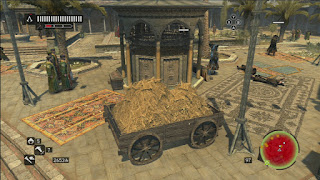While still bogged down in the quest to avoid quests in ACIII, and with a newly-charged Vita downloading games I had purchased on the webstore and forgotten about, I came across Assassin's Creed Bloodlines, a PSP game I bought for about £2 in a sale a while ago. Set between the original AC and ACII, it got middling reviews at the time of release, and I can understand why - on first impressions, it's trying to be a fully-fledged AC game, and releasing alongside the amazing ACII won't have done it any favours.
But step back from it for a bit and you realise that it's actually far better than it appears. Gone are the open, sprawling maps, replaced with small, discrete areas. Gone are the countless distractions, and the missions are a lot shorter (albeit often with multiple parts). Unlike the original game, Bloodlines is far more linear, not requiring multiple side missions before approaching the main target. This is a game designed for mobile playing, where there is no requirement for you to remember your objectives for hours on end. It may be driven by the limitations of the hardware, but the result works really well.
That's not to say there aren't frustrations. The combat is a bit clunky, especially going straight from ACIII, and the camera frequently served to frustrate this by hiding the person attacking. It is very easy to win the fights, simply by holding the right trigger (the block button) and countering, with a few exceptions of boss battles. The combat serves only as an annoyance, and I was frequently trying my best to avoid it by sneaking around the scenery. This didn't always work, particularly when I accidentally jumped off a ledge onto a guard's head - and there's no air assassination here.
What was more annoying was when there was no alternative but to fight. After each boss battle, he area was swamped with soldiers who would attack before I could run away. In addition, there were often soldiers standing guard outside the entrance to key rooms, and without the distraction tools available in later games I just had to massacre them.
I may be going a little overboard though. The combat was a minor annoyance, and the game anything but. There was a reasonably involved story, with Altaïr searching for the Templar archive where they keep lots of exciting mystery stuff. He tracks it down to Cyprus, which is where the game is set. Throughout the game, Maria (who has a very modern middle-class English accent) is slowly won over to the Assassins, as she sees what the Templars plan. There's enough tension to keep playing.
But it's not a long game. It's taken me a couple of weeks of commuting to finish it, and that includes a lot of unnecessary battles and diversions. Easily worth £2 though.
But step back from it for a bit and you realise that it's actually far better than it appears. Gone are the open, sprawling maps, replaced with small, discrete areas. Gone are the countless distractions, and the missions are a lot shorter (albeit often with multiple parts). Unlike the original game, Bloodlines is far more linear, not requiring multiple side missions before approaching the main target. This is a game designed for mobile playing, where there is no requirement for you to remember your objectives for hours on end. It may be driven by the limitations of the hardware, but the result works really well.
That's not to say there aren't frustrations. The combat is a bit clunky, especially going straight from ACIII, and the camera frequently served to frustrate this by hiding the person attacking. It is very easy to win the fights, simply by holding the right trigger (the block button) and countering, with a few exceptions of boss battles. The combat serves only as an annoyance, and I was frequently trying my best to avoid it by sneaking around the scenery. This didn't always work, particularly when I accidentally jumped off a ledge onto a guard's head - and there's no air assassination here.
What was more annoying was when there was no alternative but to fight. After each boss battle, he area was swamped with soldiers who would attack before I could run away. In addition, there were often soldiers standing guard outside the entrance to key rooms, and without the distraction tools available in later games I just had to massacre them.
I may be going a little overboard though. The combat was a minor annoyance, and the game anything but. There was a reasonably involved story, with Altaïr searching for the Templar archive where they keep lots of exciting mystery stuff. He tracks it down to Cyprus, which is where the game is set. Throughout the game, Maria (who has a very modern middle-class English accent) is slowly won over to the Assassins, as she sees what the Templars plan. There's enough tension to keep playing.
But it's not a long game. It's taken me a couple of weeks of commuting to finish it, and that includes a lot of unnecessary battles and diversions. Easily worth £2 though.


















































